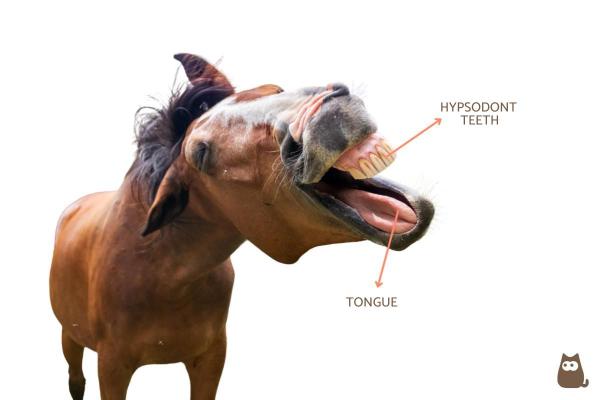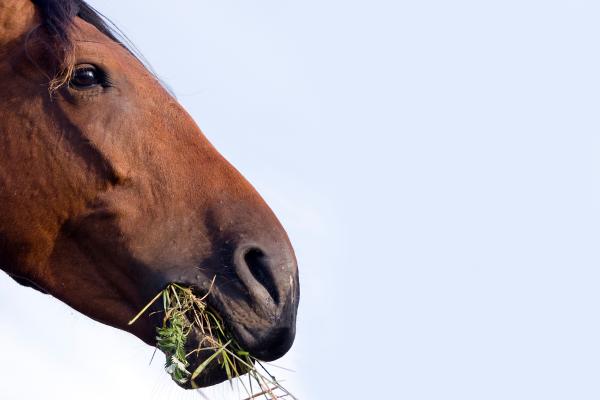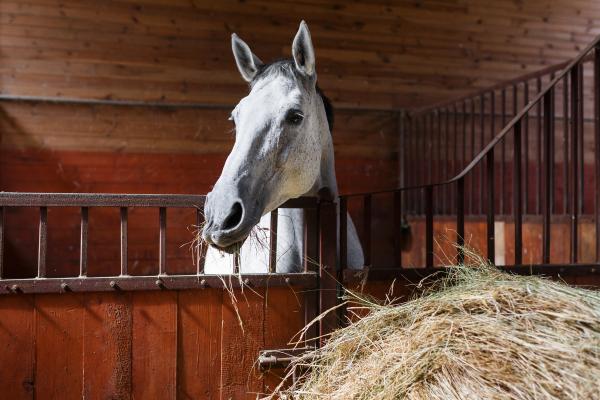
The horse's digestive system has evolved to process plant fiber continuously throughout the day. It transforms grass and hay into energy through a complex process that takes 36-72 hours. Understanding this system helps you prevent common health issues like colic and ulcers. It is so effective that horses are known for being able to extract more nutrients from fibrous plants than most mammals due to their specialized digestive features.
This AnimalWised article explains how the horse's digestive system works, detailing each step of digestion, the key organs involved, and more.
Mouth and teeth
The horse's mouth starts the digestion process. Horses have hypsodont teeth, which are teeth with high crowns that continue to grow and emerge from the gums to replace worn surfaces. Adult horses have 36-44 teeth: flat incisors in front for cutting grass, and large cheek teeth in back with ridged surfaces for grinding plant material into small, digestible particles.
The grinding process requires significant muscle power. The horse's strong jaw muscles move sideways and up and down, breaking down tough plant fibers. During natural grazing, horses make up to 40,000 chewing movements per day. The time spent chewing stimulates saliva production, which begins the digestion process.
A horse produces up to 10 gallons of saliva daily while eating. The saliva contains bicarbonate and other minerals that buffer stomach acid, protecting the stomach lining from damage. Unlike human saliva, horse saliva contains lower amounts of amylase, an enzyme that breaks down starches. This difference reflects their natural diet of grass and other fibrous plants rather than grains and sugars.
It is important to note that regular dental care maintains proper tooth wear patterns. Uneven wear can create sharp points that cut the cheeks or tongue, reducing the horse's ability to chew properly. Poor dental care leads to partially chewed food entering the digestive system, which can increase the risk of certain problems, like colic.
Did you know that a horse's diet can significantly impact its behavior and performance? Learn more in our next article.

Esophagus
The esophagus moves food from mouth to stomach through muscular contractions. This tube measures about 1.2-1.5 meters (4-5 feet) in length and connects the back of the throat to the stomach entrance. Food travels one way, toward the stomach only. This anatomical feature explains why horses cannot vomit and must eat carefully.
Food moves through the esophagus in two phases. First, the horse consciously moves food from mouth to esophagus. Then, involuntary muscle contractions (peristalsis) push food to the stomach. These wave-like movements prevent food from becoming lodged in the esophagus.
The esophagus can stretch to allow passage of food balls (boluses) but can become blocked if a horse eats too quickly or doesn't chew properly. A blockage (choke) requires immediate veterinary attention. Keep in mind that signs of choke include:
- Excessive salivation
- Repeated swallowing attempts
- Food material coming from the nostrils
Are horses ruminants like cows? Find out the answer and learn more about their digestive process.
Stomach
The horse's stomach makes up 10% of their digestive system, holding 8 to 15 liters (2-4 gallons). This small size matches their natural feeding pattern of eating small amounts often, rather than large meals. As mentioned earlier, wild horses spend 16-18 hours daily grazing, keeping their stomachs partially full.
The stomach has two main parts with different functions:
- The lower part (glandular region): produces stomach acid and digestive enzymes 24 hours a day, even without food. This continuous acid production helps break down plant material but can damage the stomach lining during long periods without food. The acid contains hydrochloric acid, pepsin, and other enzymes that break down proteins.
- The upper part (non glandular): has a mucus layer that protects it from acid damage. This region doesn't produce acid but acts as a mixing area for food and digestive juices. Empty stomachs and stress can let acid reach this area, causing ulcers. The barrier between these regions, called the margo plicatus, often develops ulcers when horses don't eat for long periods.
Food typically stays in the stomach for 15-30 minutes. The stomach releases partially digested food (chyme) into the small intestine gradually. Overfeeding, especially with grain, can overwhelm this system and increase colic risk.

Small intestine
The small intestine stretches 18-21 meters (60-70 feet) in length and processes food for 30-90 minutes. During this time, the body absorbs most proteins, fats, vitamins, and minerals. This organ adapts to different types of feed, but sudden changes can disrupt its function. Let us take a closer look at each of the parts:
Duodenum
The duodenum, the first section, measures about 1 meter (3-4 feet) long. It mixes food with pancreatic enzymes and bile from the liver. These secretions break down proteins, fats, and complex carbohydrates into smaller molecules. The pancreatic enzymes include lipase for fat digestion, protease for protein breakdown, and amylase for starch processing. Bile from the liver helps break down fats and absorb fat-soluble vitamins (A, D, E, and K).
Jejunum
The jejunum makes up most of the small intestine's length. Its wall contains millions of tiny projections (villi) that absorb nutrients into the bloodstream. Each villus contains blood vessels and lymph vessels that transport different nutrients.
The surface area created by these villi equals that of a tennis court, allowing efficient nutrient absorption. This section processes most minerals, proteins, and water-soluble vitamins.
Ileum
The ileum, the final section, absorbs vitamin B12 and remaining nutrients. It also contains patches of lymphoid tissue that help protect against harmful bacteria. A one-way valve at the end, the ileocecal valve, prevents food from moving backward. This valve's function helps explain why horses can't burp or vomit.
Large intestine
The large intestine completes the digestive process. This organ system breaks down fiber through bacterial fermentation and absorbs water and minerals. It makes up about 60% of the digestive tract and holds 75- 90 litres (20-25 gallons) of material. Let us take a look at each of the steps and parts involved:
Cecum
The cecum acts as a fermentation vat, holding 26-30 liters (7-8 gallons) of digestive contents. This organ sits on the right side of the horse's abdomen, measuring about 1.2 meters (4 feet) in length. Food material spends 7-8 hours here, mixing with billions of beneficial bacteria and protozoa.
These microorganisms break down plant fiber (cellulose) that the small intestine cannot digest. The fermentation process produces volatile fatty acids (VFAs), which provide 60-70% of the horse's energy needs. The cecum also produces B vitamins and proteins the horse absorbs.
The cecum has a specific entry and exit point at the top. This design explains why gas and material cannot easily move backward, contributing to the risk of twist or displacement that can cause colic.
Large colon
The large colon extends 3-4 meters (10-12 feet) and holds most of the digestive contents. It folds upon itself in a horseshoe shape, with various bends (flexures) that can trap gas or feed material. Feed stays here for 18-24 hours, allowing further bacterial fermentation and water absorption.
This section absorbs 95% of the water from digestive contents, along with minerals like phosphorus and electrolytes. The amount of water absorbed affects manure consistency and hydration status. Dehydration or excessive water loss here leads to impaction colic.
The bacterial population in the large colon changes based on diet. Sudden feed changes disrupt these bacteria, leading to digestive upset, colic, or diarrhea.
Small colon
The small colon, about 3 meters (10 feet) long, forms and stores manure balls. It absorbs remaining water and electrolytes. The organized muscle contractions here create the characteristic fecal balls horses produce.
A healthy horse produces 16-23 kilograms (35-50 pounds) of manure daily, split into 6-8 piles. Changes in manure consistency or production often signal digestive problems.
The entire process, from mouth to manure, takes 36-72 hours in a healthy horse. Each section plays a specific role in turning plant material into usable nutrients.

How the Horse Digestive System Functions
Horses turn plant material into energy through seven main digestive phases. Each phase prepares food for the next step, breaking it down into nutrients the horse can use.
- Taking in food: the horse takes food into their mouth, where chewing mixes it with saliva. The saliva contains amylase, an enzyme that starts breaking down starches.
- Chewing: the teeth grind plant material into small pieces. The tongue moves food between the teeth and helps form it into a ball (bolus) for swallowing.
- Swallowing: swallowing happens in two parts. First, the horse consciously moves the food ball to the back of the throat. Then, automatic muscle movements push food through the esophagus to the stomach.
- Stomach processing: the stomach both stores food temporarily and starts chemical digestion. The lower stomach section produces acid and enzymes to break down proteins and fats. The upper section mixes food with these digestive juices.
- Small intestine: the small intestine completes most digestion and absorbs nutrients.
- Large Intestine: it processes material the small intestine cannot digest. The cecum contains bacteria that break down plant fiber into energy (volatile fatty acids). The colon absorbs water and minerals, then forms manure. This process creates 60-70% of the horse's energy supply.
- Waste removal: the final section forms and stores manure until elimination. Changes in manure amount or texture often signal digestive problems.
Remember that poor dental care, sudden feed changes, or stress can disrupt this system and cause health problems like colic or ulcers.
Before you go, did you know that horses communicate through more than just vocalizations? Explore the subtle nuances of their body language.

If you want to read similar articles to How Does the Horse Digestive System Work?, we recommend you visit our Facts about the animal kingdom category.
- Alexander, F. (1972). (1) Certain Aspects of the Physiology and Pharmacology of the Horse's Digestive Tract. Equine veterinary journal , 4(4), 166-169.
- Clarke, L.L., Roberts, M.C., & Argenzio, R.A. (1990). Feeding and digestive problems in horses: physiologic responses to a concentrated meal . Veterinary Clinics of North America: Equine Practice, 6(2), 433-450.
- De Fombelle, A., Varloud, M., Goachet, AG, Jacotot, E., Philippeau, C., Drogoul, C., & Julliand, V. (2003). Characterization of the microbial and biochemical profile of the different segments of the digestive tract in horses given two distinct diets. Animal Science, 77(2) , 293-304.
- Mishra, D.B., Singh, P., Bhalakiya, N., Kumar, G., & Yadav, D.K. (2021). Chapter-10 Equine Digestive System . Emerging Trends in Applied Research, 45, 133.